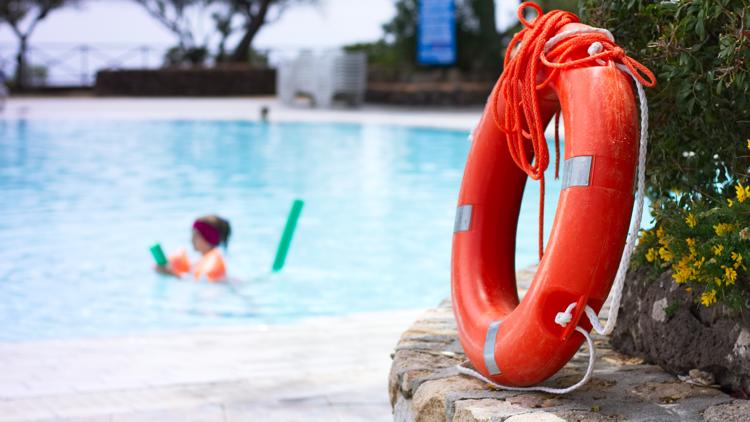Summer has begun and many pools are now open. But while swimming can be a fun way to spend the summer months, pools can be dangerous.
Drowning is the leading cause of death for children in the United States, according to the American Red Cross. Nearly 40 million adults in the U.S. don’t know how to swim, the Centers for Disease Control and Prevention report.
With the start of summer and the re-opening of pools across the country, we VERIFY how to stay safe while at the swimming pool.
THE SOURCES
- Allie Gaines, Charlotte Aquatics
- Adam Katchmarchi, Ph.D., chief executive officer at the National Drowning Prevention Alliance
- Centers for Disease Control and Prevention
- Cleveland Clinic
- Mayo Clinic
- Virginia Graeme Baker Pool and Spa Safety Act
- International Association of Certified Home Inspectors
- The Association of Pool & Spa Professionals
- United States Consumer Product Safety Commission
- A 2011 review conducted by the American Red Cross
- A water color study from ALIVE Solutions
- The Zac Foundation
- Colin’s Hope
- Hudson Valley Swim
- Dignity Health, a California hospital provider
- A Cleveland Clinic article
- An Ochsner Health article
QUESTION #1
Does chlorine cause your eyes to get red?
THE ANSWER
WHAT WE FOUND
Chlorine is one of many reasons your eyes may get red after swimming in the pool.
“Chlorine can make your eyes a little red, teary and sensitive to light for a couple of hours after you are in a pool or playing at a water park,” Richard Gans, M.D., said in a Cleveland Clinic article.
Eye redness after swimming could also be a result of chlorine combining with other substances in a pool.
When chlorine “binds to the body waste swimmers bring into pools, it can form chemicals called chloramines,” which can irritate eyes, skin and even the respiratory tract, the Centers for Disease Control and Prevention (CDC) says.
Chloramines are created when chlorine is combined with “pee, poop, sweat, dirt, skin cells, deodorant, and makeup that wash off swimmers' bodies,” the CDC adds.
Gans recommends wearing goggles while swimming to protect eyes from chlorine-related irritation.
Eye redness that persists for several hours after swimming in a pool could also be a sign of something more serious.
Some viruses that aren’t killed by chlorine could still be in the pool, leading to an eye infection, a Cleveland Clinic article says. It’s recommended to see a doctor if an eye infection is suspected.
QUESTION #2
Is it dangerous to swim within 30 minutes of eating?
THE ANSWER
WHAT WE FOUND
It’s not dangerous to swim within 30 minutes of eating. It’s a myth that doing so puts people at a higher risk of drowning due to muscle cramps or lack of blood flow.
A 2011 review conducted by the American Red Cross looked at 50 years of scientific literature and found that “eating before swimming is not a contributing risk for drowning and can be dismissed as a myth.”
The American Red Cross says it did not find any reported cases of someone drowning because they swam within 30 minutes of eating.
Claims that it's dangerous to swim within 30 minutes of eating come from the idea that your body will have to direct blood to both your digestive system and your muscles at the same time. While this is true, there is plenty of blood to go around.
“These concerns are unwarranted because your blood just isn't diverted enough to cause any real problems,” Dignity Health, a California hospital provider, said. “There are no documented deaths attributed to anyone swimming on a full stomach.”
If you do get a muscle cramp, while you’re swimming or doing anything else, it’s likely caused by dehydration, overuse of a muscle, muscle strain or simply holding a position for a prolonged period, not because of blood going multiple places at once, according to the Mayo Clinic.
QUESTION #3
Can pool drains be dangerous?
THE ANSWER
WHAT WE FOUND
Pool drains can be dangerous if the drains are not properly covered or up to standards, as defined by the United States Consumer Product Safety Commission in the Virginia Graeme Baker Pool and Spa Safety Act. Hair and body parts can become entrapped in pool drains or held down by suction, the Association of Pool & Spa Professionals says.
“When this happens, a swimmer playing with the drain may become stuck to it in a way similar to how a vacuum will stick to the palm of the hand, but with much more force; 350 pounds of pressure is normal for a pool drain, and public pools are even more powerful,” the International Association of Certified Home Inspectors explains.
There were 74 reports of drain entrapments in pools, hot tubs, spas and whirlpools between 1999 and 2007, according to the United States Consumer Product Safety Commission. Nine of those reports were fatalities.
In 2008, the Virginia Graeme Baker Pool and Spa Safety Act was passed, initiating new safety standards for pools, spas and hot tubs. It requires all drains to have covers and additional new systems to prevent drain entrapments.
Entrapment prevention systems can include safety vacuum release systems, which cease operation of the pump or reverse circulation flow when a blockage is detected, or other drain disablement mechanisms, the VGB Act says.
While most pools should be up to standard, drain covers that are cracked, broken or not up to standard could lead to serious safety issues, Colin’s Hope says.
QUESTION #4
Will arm floaties or inflatable floatation devices prevent a child from drowning?
THE ANSWER
WHAT WE FOUND
Arm floaties and inflatable floatation devices do not prevent a child from drowning, according to the CDC.
“‘Floaties,’ arm bands, or water wings do not prevent children from drowning and can easily slip off, especially when kids jump into the water,” the CDC says.
“If your child's a weaker nonswimmer, our recommendation is you are within arm's reach of your child at all times,” Adam Katchmarchi, Ph.D., chief executive officer at the National Drowning Prevention Alliance (NDPA), told VERIFY partner station KHOU.
Use of floatation devices can also create a false sense of security among those that don’t know how to swim.
“‘Routine use of flotation devices in swimming pools and other swimming sites may actually increase risk of drowning, providing the child and parents a false sense of security in the water,” the NDPA says.
"No device independently is going to teach a child to swim without proper instruction,” Katchmarchi added.
The department recommends swimming with a U.S. Coast Guard approved life jacket instead.
QUESTION #5
Are brighter-colored swimsuits easier to spot in the pool?
THE ANSWER
WHAT WE FOUND
Brighter-colored swimsuits are easier to spot in the pool.
Allie Gaines, owner of Charlotte Aquatics, told VERIFY partner station WCNC “neon colors are much better, they're easier to spot in the water."
A color test conducted by ALIVE Solutions also found that bright, neon colors showed up the best underwater; neon pink and neon orange were ranked at the top.
Lighter colors, like white and light blue, were harder to see underwater. ALIVE Solutions also recommends staying away from darker colors, like black or dark green, as they “can often be dismissed for a pile of leaves, dirt, or a shadow.”
It’s important to avoid wearing darker-colored swimsuits that are harder to spot, especially in “low-light conditions or murky water, or when there is a high degree of activity in the pool,” Hudson Valley Swim explains.
Instead, brighter colored swimsuits can make it easier for lifeguards to spot a child that may need help in the pool, Hudson Valley Swim adds.
Do you have other summer-related questions? Contact the VERIFY team at questions@verifythis.com.



